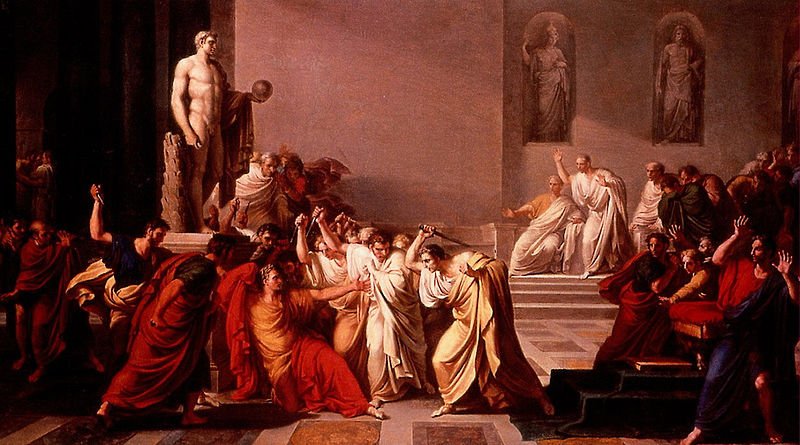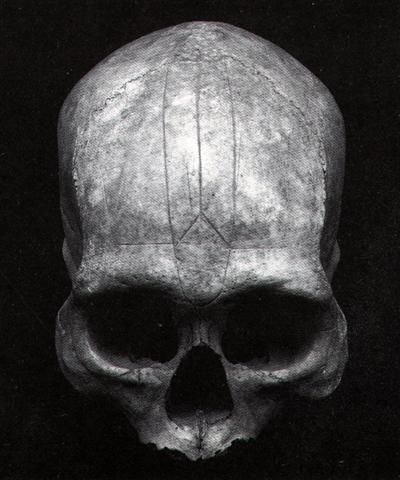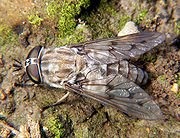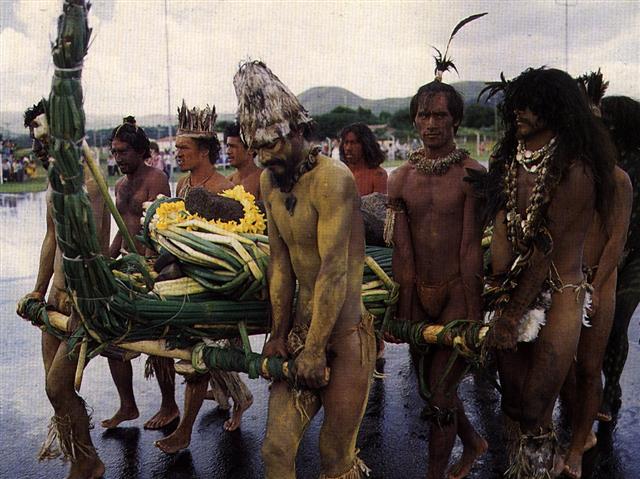In this environment - side a on the C tablet - we can early in June find a Rogo figure in poor shape:
At first sight it may appear as if he was starving, but a closer look reveals something else. He has a sagging body shape - as when the old Sun wearily is reaching down to the horizon in the west:
Which idea seems to be supported by his left arm resting on the ground: ... The chaotic tumult in the Curia (where the Senate had their meeting and where they killed Caesar) resulted in his dead body left lying on the floor, while all the Senators panicked and ran out through the door in different directions. They had planned to throw his body into the river, but the time of plans and order was in the past. Instead, in the afternoon, three of the slaves of Caesar came and fetched his body, and carried him on a stretcher to his home south of Forum - and one arm was hanging down in the corner where the 4th slave should have been ...
The hand of the dead Caesar was hanging down towards earth. He was a sun king (according to myth) and the sun king follows the path of the sun. The sun takes on different shapes (habits) depending on season (house). At the end of the year he is an old man, at the beginning he is a little child. Sun comes again after having died at the limit of the old year. In the agricultural year it means at spring equinox (or shortly before). His downfall is necessary for regeneration. The last quarter must end in a downfall. The sacred year which is vertically oriented (governed by the moon instead of the sun) has the last quarter defined by winter solstice, which explains why December 13 is the date which determines Lucia in Sweden (high in latitude and with a female sun).
The week is defined by the moon and the sacred year is the larger puzzle into which the week must fit. Therefore Sun comes first in the week (because the rebirth of the sun occurs at the beginning of the sacred year). Mars has his character defined as a light-bringer and it means he must come immediately after the pair sun and moon. I must try to keep this grand old story as short as possible, but I must also try to be convincing, because it is true and because it is necessary in translating rongorongo texts. I looked once again in Hamlet's Mill, and found another Brutus (Hamlet himself). We need him too: ... While Tarquin was thus employed (on certain defensive measures), a dreadful prodigy appeared to him, a snake sliding out of a wooden pillar, terrified the beholders, and made them fly into the palace; and not only struck the king himself with sudden terror, but filled his breast with anxious apprehensions: so that, whereas in the case of public prodigies the Etrurian soothsayers only were applied to, being thoroughly frightened at this domestic aparition, as it were, he resolved to send to Delphi, the most celebrated oracle in the world; and judging it unsafe to entrust the answers of the oracle to any other person, he sent his two sons into Greece, through lands unknown at that time, and seas still more unknown.
Titus and Aruns set out, and, as a companion, there was sent with them Junius Brutus, son to Tarquinia, the king's sister, a young man of a capacity widely different from the assumed appearance he had put on. Having heard that the principal men in the state, and among the rest his brother, had been put to death by his uncle, he resolved that the king should find nothing in his capacity which he need dread, nor in his fortune which he need covet; and he determined to find security in contempt since in justice there was no protection. He took care, therefore, to fashion his behaviour to the resemblance of foolishness, and submitted himself and his portion to the king's rapacity. Nor did he show any dislike of the surname Brutus, content that, under the cover of that appellation, the genius wich was to be the deliverer of the Roman people should lie concealed, and wait the proper season for exertion ... He was, at this time, carried to Delphi by the Tarquinii, rather as a subject of sport than as a companion; and is said to have brought, as an offering to Apollo, a golden wand inclosed in a staff of cornel wood, hollowed for the purpose, an emblem figurative of the state of his own capacity. When they were there, and had executed their father's commission, the young men felt a wish to enquire to which of them the kingdom of Rome was to come; and we are told that these words were uttered from the bottom of the cave - 'Young men, whichever of you shall first kiss your mother, he shall possess the sovereign power at Rome' ... Brutus judged that the expression of Apollo had another meaning, and as if he had accidentally stumbled and fallen, he touched the earth with his lips, considering that she was the common mother of all mankind ... This piece is cited from Livy, and puts Hatinga Te Kohe into a new perspective. Out from the staff (wooden pillar) comes a golden snake crawling, forewarning of the golden wand inside the hollow 'bamboo'. Kissing the earth means the morning star is reaching the horizon and forewarning of the soon rising sun. North of the equator it should be Aldebaran, south of the equator Antares ('the other side Mars'). Though the act of bowing down to kiss the horizon refers to the west and an evening star, more symbolic of the death waiting for the current king. We understand why Hamlet asked himself if it was better to die than to live forever, holding the dead skull.
He had the capacity to make a choice, to either remain as an eternal and predictable god high up in the sky or to bring his power into action (movement, life, light). Mars is making strange and sometimes retrograde motions in the sky, indicating a living entity. He is only half god ...
I think this phase of the developments should be explained from the position in the year.
I.e., at the end station in the river of time Rogo was 'laid to rest on a platform' (hata) - or put into a box (flesh eater, sarcophagus) - perhaps after having been mortally wounded at the apex, where his orientation had been forced around from ascending to facing down (towards the off-spring). ... When this tremendous task had been accomplished Atea took a third husband, Fa'a-hotu, Make Fruitful. Then occurred a curious event. Whether Atea had wearied of bringing forth offspring we are not told, but certain it is that Atea and her husband Fa'a-hotu exchanged sexes. Then the [male] eyes of Atea glanced down at those of his wife Hotu and they begat Ru. It was this Ru who explored the whole earth and divided it into north, south, east, and west ...
... All the kinsmen spoke to you (i.e. Kuukuu): 'Even you did not prevail against the turtle!' They put the injured Kuukuu on a stretcher and carried him inland. They prepared a soft bed for him in the cave and let him rest there ... ... But Osiris's evil brother, Set, whose sister-wife was the goddess Nephtys, was mortally jealous both of his virtue and of his fame, and so, stealthily taking the measure of his good brother's body, he caused a beautifully decorated sarcophagus to be fashioned and on a certain occasion in the palace, when all were drinking and making merry, had it brought into the room and jestingly promised to give it to the one whom it should fit exactly. All tried, but, like the glass slipper of Cinderella, it fitted but one; and when Osiris, the last, laid himself within it, immediately a company of seventy-two conspirators with whom Set had contrived his plot dashed forward, nailed the lid upon the sarcophagus, soldered it with molten lead, and flung it into the Nile, down which it floated to the sea ...
Manuscript E has placed the first type of the remains - he makere - as item number 11 in the list of yam varietes [E:62]:
Whereas the 2nd type of 'cockroach' - he hata - did not belong among the stolen water yams - presumably because it was a desiccated old carapace. Varu. 1. To cut one's hair (te puoko). 2. To shave. 3. To paint, to put on make-up: he varu te kiea. Varu a-roto, to have diarrhoea. Vanaga. 1. Eight. 2. To shave, to remove the beard, to shear, to clip, to rasp, a plane. Varuvaru, to peel, to remove the bark, to plane, to scrape, to shear. Churchill. Varua. Spirit, soul; sleep, dream. This is a Tahitian word, but the same term may have been used in ancient times. Vanaga. In Bierbach the accumulated evidence connected varua with mummification and how the hair was removed (varu), the body fluids drained (varu a-roto) and after a period of 2 months it was make-up time (he varu te kiea): ... Embalming is known and practised with surprising skill in one particular family of chiefs. Unlike the Egyptian method, as described by Herodotus, it is performed in Samoa exclusively by women. The viscera being removed and buried, they, day after day, anoint the body with a mixture of oil and aromatic juices. To let the fluids escape, they continue to puncture the body all over with fine needles. In about two months, the process of desiccation is completed. The hair, which had been cut and laid aside at the commencement of the operation, is now glued carefully on to the scalp by a resin from the bush. The abdomen is filled up with folds of native cloth; the body is wrapped up with folds of the same material, and laid out on a mat, leaving the hands, face, and head exposed ...
Sa.: fata, a raised house in which to store yams, a shelf, a handbarrow, a bier, a litter, an altar, to carry on a litter; fatāmanu, a scaffold. To.: fata, a loft, a bier, a handbarrow, to carry on a bier; fataki, a platform. Fu.: fata, a barrow, a loft; fatataki, two sticks or canes attached to each other at each side of a house post to serve as a shelf. Niuē: fata, a cage, a handbarrow, a shelf, a stage, (sometimes) the upper story of a house. Uvea: fata, a barrow, a bier. ... This stone statue was carried on a stretcher (tupatupa) to be the first item brought onboard the Royal Double Canoe, and she had been fetched from the middle of the yam plantation - i.e. at Adhil, where the Middle Star Pillar, Ana-roto, was at the Full Moon. Here Adhil (the star ξ Andromedae - between her legs) and Spica (α Virginis) formed a pair of opposites, one of them together with the Sun during the winter (Hine-takurua) and the other during summer (Hine-takurua):
... I remember from my early readings (Thor Heyerdahl, Påskön, en gåta som fått svar.) how they low down among the other stones in the wall of Ahu Naunau in Anakena found a crowned head broken off at the neck, and clearly it was from a stone statue which headless earlier had been brought to Norway. For the Easter Islanders the immediate response to the new discovery was La Reina! - it just had to be their ancient queen Avareipua. Old people cried emotionally ... Fotuna: fata, a stage. Ta.: fata, an altar, a scaffold, a piece of wood put up to hang baskets of food on; afata, a chest, a box, a coop, a raft, a scaffold. Pau.: fata, a heap; afata, a box, a chest. Ma.: whata, a platform or raised storehouse for food, an altar, to elevate, to support.
Moriori: whata, a raft. Mq.: fata, hata, hataá, shelves. Rapanui: hata, a table. Ha.: haka, a ladder, an artificial henroost; alahaka, a ladder. Mg.: ata, a shelf; atamoa, a ladder; atarau, an altar. Mgv.: avata, a coffer, a box. Vi.: vata, a loft, a shelf; tāvata, a bier. The Samoan fata is a pair of light timbers pointed at the ends and tied across the center posts of the house, one in front, the other behind the line of posts; rolls of mats and bales of sennit may be laid across these timbers; baskets or reserved victuals may be hung on the ends. The litter and the barrow are two light poles with small slats lashed across at intervals. The Marquesan fata is a stout stem of a sapling with the stumps of several branches, a hat tree in shape, though found among a barehead folk. These illustrations are sufficient to show what is the common element in all these fata identifications, light cross-pieces spaced at intervals. With this for a primal signifaction it is easy to see how a ladder, a raft, a henroost, an altar come under the same stem for designation. Perhaps Samoan fatafata the breast obtains the name by reason of the ribs; it would be convincing were it not that the plumpness of most Samoans leaves the ribs a matter of anatomical inference. Churchill 2.
Kavakava, rib; moi kavakava, a house god G. P Mgv.: vakavaka, the breast. Mq.: vakavaka, vaávaá, rib. Ma.: wakawaka, parallel ridges. We shall need all the available material in order to determine the germ sense of this word. Sa.: va'ava'a, the breast-bone of a bird; fa'ava'a, the frame as of a slate. To.: vakavaka, the side. Fu.: vakavaka, the side below the armpit. Ha.: hoowaa, to make furrows. In all these we may see the idea of ridge or depression, or of both, as primal (Rapanui, Samoa, Marquesas, Maori, Hawaii), and as secondary the part of the body where such appearances is common (Mangareva, Tonga, Futuna). Churchill.
|
|||||||||||||||||||||||||||||||||||||||||||||||||||||||||||||||||||||||||||||||||||||||||||||||||||||||||||||||||||||||||||||||||||||||||||||||||||||||||||||||||||||||||||||||||||||||||||||||||||||















.jpg)





.jpg)



